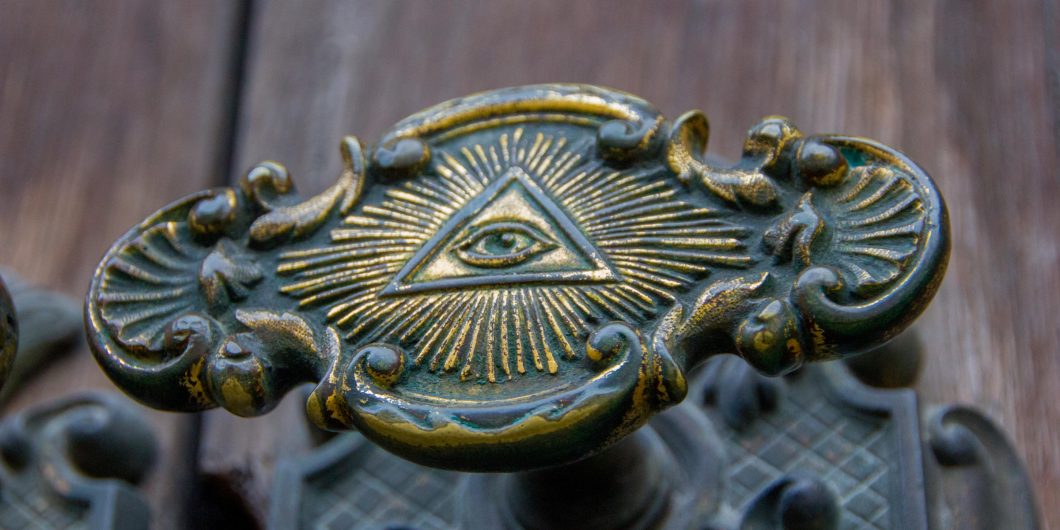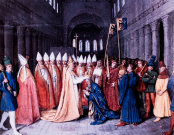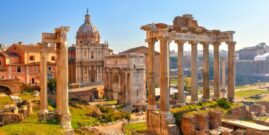Clarifying the relationship between liberal democracy and Catholicism in America for those whose history doesn’t go further back than the 1980s.
Conspiracies à la française for American Catholics
In 1798, Abbé Augustin Barruel, SJ published Memoirs Illustrating the History of Jacobinism. It was among the first efforts of French Catholics to comprehend the nature and origin of the French Revolution. With all volumes published, the work came to 900 pages. According to Barruel, the French Revolution began because of what we today call “the Enlightenment.” The Enlightenment was a complex series of movements with several leaders collaborating for its ultimate success. In Barruel’s telling, these included Voltaire, Jean-Jacques Rousseau, Baron de Montesquieu, the French Freemasons, and the Bavarian Illuminati. All were part of an intricate plot to bring down the French throne and altar. It makes for gripping reading (at least the parts that I read; I admit not to finishing it). It is also insane. Even Joseph de Maistre—no stranger to conspiracy—condemned it, though perhaps because de Maistre, despite being Catholic, was neck-deep in pre-revolutionary Freemasonry and Martinism. No doubt he did not appreciate being implicated in the Revolution he deplored.
As with all modern conspiracy theories, Barruel did not so much appeal to evidence but rather engaged in motivated reasoning. Since the publication of Barruel’s volumes, his conspiracy theory has had tremendous staying power, as it reduces the complicated series of events to a small number of nefarious actors and ideas. Another feature in the Memoirs is who escaped Barruel’s blame—the throne and altar. Barruel quibbles with royal and religious authorities, but they were, in his view, doing their best.
While Voltaire and Rousseau are long dead and the Bavarian Illuminati long gone (or are they?), for the Barruelian devotee, their ideas persist and must be exterminated to reverse the effects of the French Revolution. Currents of Barruelian-style conspiracy theory run deep in more traditional Catholic intellectual circles, and they spring to the surface when these Catholics wish to come to grips with rapid social change that contradicts Catholic teaching. The recourse to Barruelian-style conspiracy is comforting to the fearful both by simplifying the social change to a small set of ideas and by leaving the Church blameless.
For example, during the height of the Americanism controversy of the 1890s, Canon Henri Delassus of Cambrai condemned the (by then deceased) American convert, priest, and founder of the Paulists, Servant of God Fr. Isaac Hecker for reconciling the faith and American culture. Delassus also accused American bishops of collaborating with the Universal Jewish Alliance to form a “Judaeo-Masonic sect” to promote “religious indifference.” Keeping with the Barruelian model of conspiracy theory, Delassus simplified a complex event by substituting facts of the controversy with innuendo of shadowy operators undermining the faith.
The truth, as Fr. Thomas T. McAvoy, C.S.C., detailed in his sadly out-of-print volume, The Great Crisis in American Catholic History, 1895-1900, is more complicated. McAvoy details at least three reasons for the Americanist controversy. The details are too long to repeat here, but they include a misunderstanding over the role American prelates could play in the Spanish-American war, German-American Catholics sick of an Irish-American Catholic bishop, and a series of lectures Archbishop John Ireland of St. Paul, Minnesota, gave across Europe. Delassus had a poor grip on Hecker’s work and no evidence for his claims, but he was quite aware of the rise of both America as military power and American Catholic republicanism as a rival to the frequently reactionary politics of European Catholicism. Therefore, in lieu of prudent reflection on complicated issues, Delassus blamed the Jews and Freemasons.
In 2015, America experienced what felt to Catholics like a rapid social change, namely the constitutional protection for same-sex marriage. Many conservative Catholics had placed their faith in state amendments, a federal statute, and perhaps even a slim conservative majority on the Supreme Court to prevent such change. Yet the change came. Catholics then had to consider how to live in a nation where the federal government imposed a marriage law contrary to the faith. The late Peter Augustine Lawler and Richard Reinsch II considered this matter soberly in A Constitution in Full: Recovering the Unwritten Foundation of American Liberty, concluding, “the future of marriage is open, and the court has no authoritative insight about…the combination of privileges and responsibilities that gives weight and direction to both worthwhile work and relational love.” Moreover, the Supreme Court decision itself amounted to a debate among liberal and conservative Catholics with “a devotion for the relational institution of marriage, and even the relational institution of their church.”
Others felt betrayed by radical social change and have sought out simplified accounts of a rather complex story, just as Barruel did. Many authors, including me, have discussed these figures in detail elsewhere. Two additional figures must be added to the list: the prolific American theologian Scott Hahn and his co-author Brandon McGinley, who is quickly emerging as a thoughtful and serious writer on the Catholic Church. No doubt they would be surprised to be associated with Barruelian conspiracy theory. They do not appeal directly to Barruel’s Memoirs in their recent book, It Is Right and Just: Why the Future of Civilization Depends on True Religion. Perhaps neither has even heard of the old French Jesuit. However, Barruel’s conspiracy of the Enlightenment has outlived the fame of its original author and, as with the Americanist controversy, has become a regrettable genre of conservative Catholic commentary. It has lived on, in books like this one, as a salve for traditional Catholics frustrated with an imperfect world and a clergy that often lets them down.
Civilization and True Religion
Let’s begin by considering the argument Hahn and McGinley intended. The book places its thesis in the title. They argue that the restoration of civilization requires all peoples to adopt the Catholic faith. They explain how, by reason alone, a person can conclude that humans are social creatures, born into families who congregate into communities. The community is the thing that all persons and families share, making it a higher-order good. In short, the peace of the community is common to all, and its good is the common good.
The need for virtues like justice and prudence point to the general human need for virtue to perfect human nature. However, persons are not capable of sufficient virtue alone because of human sinfulness. Therefore, for a community to be truly just it must also meet its obligation to the only source of perfection available in an imperfect world, and these obligations are found in the Church and its Sacraments.
While the natural end of the community is peace, peace is of two kinds. There is the peace the community on its own can foster by preventing violence, but the Church provides the promise of a future peace in Christ. This latter peace is the ultimate end for all communities, and only when communities serve this ultimate end are they civilized. For that reason, the community must obey the Church in facilitating the public role of religion.
Whereas Hahn and McGinley seek to offer an account of the political implications of Catholic social teaching, their narrative is ultimately a softer form of integralism: Civilization is only found where there is this public role for the Church. Given the common disregard for virtue and the present state of the family, community, and Church, civilization is mostly impossible. The Church preaches, but there are few ears to hear.
Much of this discussion is excellent as a primer in Catholic social teaching. There are a few small things to mention here. First, the transition from chapters on pagan philosophers to Catholic theologians gives the unfortunate impression that Catholicism is simply an intellectual project. Second, these chapters could have benefited from engaging with other scholars, such as Mary Keys, Russell Hittinger, and the late Fr. James V. Schall, SJ. These are quibbles, but they could have been addressed in an introduction, which this book lacks. The most serious issue with the book is its rehabilitation, however inadvertent, of an old conspiracy theory.
The Enlightenment Conspiracy
Obergefell v. Hodges is repeatedly raised in the book. The shock of this decision appears to be the underlying motivation for writing It Is Right and Just. Chapter after chapter references same-sex marriage as an especially dire issue, because it defies, in their view, the very nature of the human person that is knowable even to the pagans. What happened?
The culprit is the Enlightenment, and here the book unfortunately lapses into the Barruelian conspiracy. Were it not for the Enlightenment, the achievement of civilization under European Christendom would remain an integrated whole in which the person, family, community, and Church were rightly ordered to the temporal good of peace and the spiritual good of salvation. The Reformation fractured that integrated whole, and liberalism emerged from religious violence promising a false peace realized by the individual pursuit of material goods to the exclusion of duties one owed to family, community, and God.
Hahn and McGinley complain of “globetrotters attached to elite institutions, who make it their business to tell everybody that everything from the economy to culture is going just great.” The discourse surrounding the elite cosmopolitan wanderers is fraught, to say the least. There is a telling hesitation to identify who these agents are, but in one case, they move from John Adams to Rousseau to Jeremy Bentham in a matter of a few sentences:
Adams realized that the regime he had helped build required a substrate of virtue among the people. While his own religious views were more or less indifferentist (except inasmuch as they were anti-Catholic), Adams recognized in a dim way that religion is more important than political institutions in forming and maintaining society.
The early secularists, though, argued that the connection between religion and society could and must be short-circuited. Peace and progress, they felt, could only be achieved when differences of supernatural worldview were put behind us and we submitted to the general will (as in Jean-Jacques Rousseau) or a strict utilitarianism (as in Jeremy Bentham) or some other “objective” basis for social organization.
To link Adams, Rousseau, and Bentham requires skirting a vast number of differences among them, and the effort itself illustrates how absurd the old Barreulian conspiracy is. Of course, Adams had read Rousseau’s A Discourse upon the Origin and Foundation of the Inequality among Mankind and, in 1794, composed three letters of over a hundred pages to his son Charles on how “the Book appears to me to be full of Errors pernicious to Mankind.” Bentham was not much more generous, jesting that Rousseau’s definition of law under the general will, “annulled, in advance, all those which may hereafter be made by any of the nations upon earth, except perhaps in the republic of San Marino.” As it turns out, the “Enlightenment” has no unified internal position on these matters, even granting that one would want to include Adams (too obscure for Europeans) and Bentham (too late). Moreover, Hahn and McGinley are giving these thinkers far too much credit for the tectonic shifts among numerous nations and cultures over the course of history. Filling all these gaps is more Barruelian conspiracy. Again, there is no admission that they are playing fast and loose here. This is just how things appear to them.
“The Great Washington” and the American Catholic Tradition
Hahn and McGinley particularly criticize the writings of two American Founders, George Washington and Benjamin Franklin, the latter of whom they decry for his deism. Deism is, for Catholics, a heresy often attributed to Freemasonry. Franklin and Washington were both Freemasons and therefore, for some traditional Catholics, must necessarily be hostile to the Church. This helps makes sense of why Hahn and McGinley assume animus when reading Washington’s letter “to Roman Catholics in America.” Hahn and McGinley note that Washington penned “a patronizing barb” when he says, “And may the members of your society in America, animated alone by the pure spirit of Christianity, and still conducting themselves as the faithful subjects of our free government, enjoy every temporal and spiritual felicity.” Their criticism is that Washington did not take the opportunity to articulate the true religion of the Catholic faith. Such a conclusion does not square with the longer American Catholic tradition, such as that expressed by Bishop Thomas O’Gorman of Sioux Falls, who called Washington’s letter “one of [America’s] most precious heirlooms.” Who is right?
Washington wrote this letter in March of 1790 while serving as President, and his letter was a reply to one written by Father John Carroll, brother of Charles Carroll of Carrollton, the only Catholic signer of the Declaration of Independence. Carroll said first to Washington:
From these happy events, in which none can feel a warmer interest than ourselves, we derive additional pleasure by recollecting, that you, Sir, have been the principal instrument to effect so rapid a change in our political situation…because whilst our country preserves her freedom and independence, we shall have a well founded title to claim from her justice equal rights of citizenship, as the price of our blood spilt under your eyes, and of our common exertions for her defence [sic], under your auspicious conduct, rights rendered more dear to us by the remembrance of former hardships.
What “hardships” were those? Catholics during Washington’s presidency were a small minority subject to regular persecution and discrimination. Indeed, the original impetus for the Carroll letter to Washington was the ongoing argument over whether America was a fundamentally Protestant nation. Washington’s letter indicated that he sided with Carroll, which up-ends the depiction Hahn and McGinley give it. After all, it was Washington who put a stop to Guy Fawkes Day celebrations in the Revolutionary Army. He helped fund the building of a Catholic Church in Baltimore, attended a Mass to show solidarity with American Catholics. Carroll, for his part, became bishop a few months after publicly corresponding with Washington, in August of 1790, because of the diplomatic arrangement made with the Vatican, one which Franklin helped negotiate.
When one clears away the Barreulian fear and loathing, one finds American Catholics overjoyed with the post-revolutionary circumstances, as letters from Carroll to Franklin and Washington indicate. No wonder then that in 1899 Pope Leo XIII called him “the great Washington.” American Catholics used to know this history, but now even prominent Catholic authors seem to have never learned it and, hence, opt for conspiracy.
What is more, the book seems especially strange in a time when most senior figures in the federal government are, in fact, Catholic. President Joseph Biden, Speaker of the House Nancy Pelosi, and several justices of the Supreme Court are Catholic. The trouble with Catholics like Biden and Pelosi is that they are the liberal, cultural Catholics who repudiate the role the Church plays in informing their constitutional obligations. Are the tendrils of the Enlightenment reaching into their souls and pulling them away? Have they been reading Washington’s Farewell Address?
Or does the clergy of the Church sometimes fail the faithful? American bishops, after all, have recently pulled their punches, or at least Pope Francis pulled their punches for them. And here is what neo-Barruelians work so hard to avoid observing: Catholic priests sometimes behave badly, and this has consequences for public life. Had American bishops been prophetically upbraiding elected officials on issues of true justice for decades, rather than issuing bloodless press releases or bureaucratically shuffling predatory priests, the faithful would be more numerous and more willing to heed their call.
Up from Barruelianism
I wish to reiterate that I think highly of Hahn and McGinley. McGinley and I even engaged in a fun, spirited debate about American Catholicism a few months ago. Much of what they present is worthwhile reading, but it is too often marred by shifting blame onto sinister outside forces rather than looking inward. Indeed, such a problem came as a surprise, given McGinley’s recent work that attempted to wrestle with this very issue.
A sober assessment of the Catholic present and future requires a reacquaintance with the long tradition of American Catholics as a religious minority, fighting for libertas Ecclesiae and freedom of conscience. These are not merely the product of vague, “Liberal” forces, but hard-won political victories in need of defending. As in the past, these are fights Catholics cannot fight alone and certainly cannot win by battling the same kind of phantoms once summoned by a deranged French Jesuit two centuries ago.


